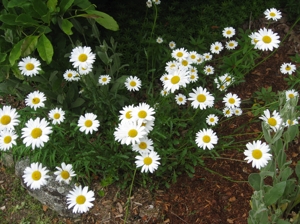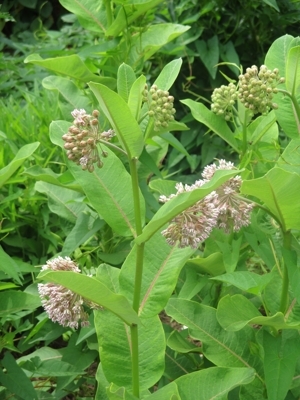Recent years have seen a burgeoning interest in the cultivation of wildflower meadows. Wildflower meadows are viewed along the highways, featured in gardening magazines and sold as “meadow mixes” in many garden centers and horticultural catalogs. A popular misconception is that wildflower seeds can just be sprinkled on an area, and they will grow with little care or maintenance. To create a successful wildflower meadow, it is helpful to have a basic understanding of plant succession – the process by which one community is replaced by another until a self-sustaining or climax community is achieved. In many parts of Connecticut, an oak, hickory and hemlock forest represents the climax community. A disturbed area with exposed soil is first colonized by annual plants followed by perennials, shrubs and then finally tree species. Unless the annual/perennial stage is maintained, the meadow will soon be inhabited by tree and shrub species.
Choosing the Right Species
Many meadow mixes contain mid-western and western native wildflowers as well as seeds from exotic wildflowers and vibrant annuals. Planting one of these mixes in New England will probably result in a colorful meadow the first year but most species will disappear the next season. Very few will self-sow.
Grasses are found in many meadow mixes and provide a golden touch of color in late fall. Recommended meadow grasses include big and little bluestem (Andropogon geradii, A. scoparius), sideoats grama (Bouteloua curtipendula), Indiangrass (Sorghastrum nutans), lesser quaking grass (Briza minor), prairie dropseed (Sporobolus heteropepis) and sheep fescue (Festuca ovina). Vigorous grass species such as tall fescue (Festuca elatior), orchard grass (Dactylis glomerata) and rye grass (Lolium erenne) should be avoided as they will outcompete flowering species. As a rule, grasses should compose no more than 10 to 15% of the mixture.
Site Selection and Preparation
Wildflower meadows generally look best when situated in a semi-natural location. They may be planted along a woodlot, bordering the lawn or patio, against a fence or adjacent to the property line. Select a well-drained site receiving 6 to 8 hours of sun each day. Good site preparation is essential in establishing a wildflower meadow. Grasses and weed species should be removed from the area and the soil should be cultivated to a depth of approximately 6 inches. Meadow wildflower seeds germinate best when in contact with bare loosened soil.
Site preparation can be done by one of 4 different techniques:
1. Till the area 6 to 8 weeks prior to planting removing all existing undesirable vegetation. Repeat cultivations every 2 to 3 weeks as necessary to eliminate any newly-germinated weeds or aggressive offenders.
2. Rototill the area approximately 6 weeks in advance of sowing, and then rake. Allow the weeds to grow back for about 3 weeks and spray with a non-selective herbicide. This herbicide will finish off any remaining weeds and break down rapidly under most conditions. The dead vegetation should be removed before planting.
3. Black plastic sheeting topped with 3 or 4 inches of mulch can be laid down at least 2 or 3 months before planting. This should kill most vegetation underneath it. After the black plastic is removed, cultivate the area and rake up the dead vegetation. Be aware that some stubborn weeds might need to be dug up.
4. Remove existing sod using a spade for small areas or with a rented sod cutter for larger sites.
While established wildflower meadows generally do not need regular fertilization, often it is necessary to adjust the pH and add nutrients to new plantings. This is especially important if you are planning to incorporate garden perennial species as part of the planting.
| Common Name | Latin Name |
| Bee Balm | Monarda didyma |
| Bird's Foot Violet | Violoa pedata |
| Black-eyed Susan | Rudbeckia hirta |
| Chicory | Cichorium intybus |
| Common Milkweed | Asclepius syriaca |
| Compass Plant | Silphium laciniatum |
| Coneflowers | Echinacea spp. |
| Coreopsis | Coreopsis spp. |
| Evening Primrose | Oenothere lamarckariana |
| Goldenrod | Solidago spp. |
| Great Blue Lobelia | Lobelia siphilitaca |
| Joe-pye Weed | Eupatorium maculatum |
| Lady's Bedstraw | Galium verum |
| Liatris | Liatris spicata |
| New England Asters | Aster spp. |
| Ox-eye Daisy | Leucanthemum vulgare |
| Queen Anne's Lace | Daucus carota |
| Red Clover | Trifolium pratense |
| Yarrow | Achillea millefolium |

Oxeye Daisy

Common Milkweed
Have a soil test performed to determine the pH and nutrient levels. Limestone can be added if necessary to raise the pH to around 6.0. Follow the fertilizer recommendations that are supplied with soil test report. Avoid excessive fertilization as it can stimulate the growth of weedy grasses that will outcompete flowering species. Good drainage is critical in the establishment of most wildflower meadows. The addition of a low nutrient organic matter, like leaf compost, can improve drainage capabilities and aid in moisture retention. A cover crop of buckwheat or annual rye can be planted and tilled in before sowing and this will also raise the soil organic matter levels.
Sowing
Seeds may be purchased as prepared mixes or individually by species. Selection by species is often more rewarding as you can choose colors, blooming periods and varieties most suited to your location. Generally, a total of 4 to 5 pounds of seed are necessary to cover an acre. Sowing can be done in the spring or fall. Choose a windless day for sowing.
Divide the total quantity of seed in half. Spread one half of the seed over the entire area in one direction, for example north to south. Then spread the other half in a perpendicular direction like east to west. This method helps to avoid bare spots. Go over the seed with an empty lawn roller to ensure good seed contact with the soil or tamp the seed lightly with the edge of a grading rake.
Cover the newly-seeded area lightly with mulch hay, and keep the seedbed moist until the seeds germinate. Germination usually occurs in 1 to 4 weeks although some perennials may need a period of cold stratification over the winter to germinate. Continue to provide about 1 inch of water each week until seedlings establish themselves.
Maintenance
Weed control is essential for successful wildflower establishment. Learn to recognize aggressive weed species, and hand weed any intruders. Another option is to go over the bed with a grass trimmer or a hand scythe, and slice the tops off weed species before they set seed. This procedure may need to be repeated 3 or 4 times throughout the first growing season. Herbicides are not recommended, as they will also eradicate desired species. If annuals are included in the meadow planting, some color will be evident the first year. Generally, it takes 2 to 3 years for perennial plants to become established.
Once established, little watering is required except during periods of prolonged drought. Except for weeding out undesirables, the only other maintenance necessary on a regular basis is mowing once a year in late fall or very early spring. If the cut vegetation is very dense and will smother the remaining plants, rake some of it out but leave some seed heads as well.
Alternative Ways to Establish a Meadow
Although starting a wildflower meadow from seed is usually the most cost efficient and least laborious way to establish one, other alternatives are available. Many varieties of seeds may be started inside and the young transplants then moved into the prepared site. Other plants suitable for naturalizing may be purchased in garden centers or by mail order. Small beds can be prepared throughout the area and planted with perennial flowers. These beds can then be expanded on a yearly basis if desired. Some garden centers and nurseries are also offering wildflower sod, which can be laid down similarly to a sod lawn. Check varieties for suitability to your site.
For pesticide information or other questions please call toll free: 877-486-6271.
References:
Nursery Sources: Native Plants and Seeds, New England Wildflower Society, Garden in the Woods, Hemenway Road, Framingham, MA 01701
Growing and Propagating Wild Flowers by Harry Phillips, University of North Carolina Press, P.O. Box 2288, Chapel Hill, NC 27514
The Wildflower Meadow Book by Laura C. Martin, Fast and MacMillan Publishers, East Wood Press Books, Charlotte, NC
A Garden of Wildflowers, 101 Native Species and How to Grow Them by Henry W. Art, Storey Publications, Pownal, VT
A Gardener’s Encyclopedia of Wildflowers by C. Colston Burrell, Rodale Press, 1977
The Blooming Lawn: Creating a Flower Meadow by Yvette Verner, Chelsea Green Publishing Co., 1998
By D. Pettinelli, UConn Soil Nutrient and Analysis Laboratory, 2005